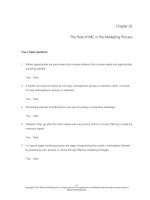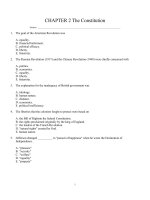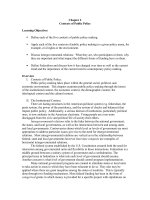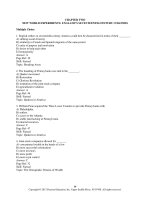American public policy an introduction 10th edition cochran test bank
Bạn đang xem bản rút gọn của tài liệu. Xem và tải ngay bản đầy đủ của tài liệu tại đây (370.92 KB, 16 trang )
Chapter 2
Contexts of Public Policy
Learning Objectives
Define each of the five contexts of public policy making.
Apply each of the five contexts of public policy making to a given policy arena, for
example, civil rights or the environment.
Discuss intergovernmental relations: What they are, who participates in them, why
they are important and what impact the different forms of funding have on them.
Define Federalism and discuss how it has changed over time as well as the current
trend and the importance of the current trend to contemporary policy making.
Overview
I. Contexts of Public Policy.
Public policy-making takes place within the general social, political, and
economic environment. This chapter examines public policy making through the lenses
of the institutional context, the economic context, the demographic context, the
ideological context and the cultural context.
II. The Institutional Context.
There are lasting structures in the American political system (e.g. federalism, the
party system, the power of the presidency, and the system of checks and balances) that
impact public policy. Additionally, a serious distrust of institutions, particularly political
ones, is now endemic in the American electorate. Young people are even more
disengaged from the civic and political life of society their elders.
Intergovernmental relations refer to the links between the national government,
the states, and local governments, as well as the interactions between and among states
and local governments. Controversies about which level or levels of government are most
appropriate to address particular issues give rise to the need for intergovernmental
relations. Most intergovernmental relations are vertical as in the relationship between
federal, state and local governments however Interstate compacts are examples of
horizontal intergovernmental relations.
The federal system established by the U.S. Constitution ensured both the need for
interaction among governmental units and flexibility in those interactions. Federalism is a
middle ground between a unitary system of government and a confederation. The
principal issue in federalism is what role each level of government should assume.
Another concern is what level of government should control program implementation.
Many national government programs are created to stimulate states or local units
to take action in areas in which they have been reluctant to do so. They also may be
applied where there are great inequities among the states or localities. This is typically
done through two funding mechanisms. Most federal funding has been in the form of
categorical grants in which money is provided for a specific project with stipulations on
exactly how the money can be used. Fewer restrictions are attached to block grants,
which give money to state or local units for general purposes instead of a specific project.
Another form of funding is General revenue sharing, which refers to the transfer of
money from one level of government to another with little or no restriction on its use.
Unfunded mandates are requirements imposed on state and local governments with no
national government funding to implement them.
Numerous groups or special interests participate in intergovernmental relations.
The executive branch of government and the courts are significant actors in the process as
are state and local government officials. In addition the recipients of services under
intergovernmental programs often participate in intergovernmental policy development.
The American Council on Intergovernmental Relations (ACIR) studies and reports on
intergovernmental issues and recommends improvements.
Intergovernmental relationships developed slowly during the first century and a
half of the nation’s history because of the rural nature of the country and relatively
uncomplicated nature of the responsibilities of the national government and the states. In
the late nineteenth century, intergovernmental relationships began to develop more
formally and from the1930s onward changes occurred much more rapidly than they had
in the past.
The emphasis in intergovernmental relations is often on fiscal relationships, but
there are other forms of interaction as well. Intergovernmental relations include
regulations and voluntary cooperative efforts.
Four types of regulations that are part of intergovernmental relations: direct orders,
cross-cutting requirements, crossover sanctions, and partial preemption. Direct orders
either prohibit or mandate state and local government actions. Preemption is a form of
direct order that imposes requirements or prohibitions on states or local governments.
Cross-cutting requirements are those in which a condition in one law is applied to all
programs using federal funds. Crossover sanctions are sanctions applied to one area or
activity for failure to comply with certain conditions in another area. Partial preemption
refers to situations in which the national government requires or permits states to
administer policies as long as the states meet federal criteria for the program.
States and local governments have grown as the national government has expanded
its involvement in domestic policy issues. The result has been more and more
intergovernmental activities and a more complex web of relations. Administrative
problems are seen in disputes in interpreting program criteria and rules and regulations
which take a long time to resolve, and conflicting rules and regulations and duplication of
effort. By giving state and local officials more discretion in the structure of their
programs block grants and general revenue sharing should subject funding to fewer
restrictions but conflicts develop within the state block-grant administrative agencies.
In granting money to other units of government, the national government tries to
see that the money is used properly and for beneficial programs and so monitoring
becomes important. It is the goal of monitoring to reduce overlapping projects and
ensure that one project does not work at cross-purposes to another to create taxpayer cost
savings through increased efficiency but there is no hard evidence that such objectives are
met.
With grants, state and local levels are never certain what amount of money is
going to be available from year to year. This uncertainty in the level of funding makes it
more difficult for them to plan their own activities and budgets. Block grants and general
revenue sharing combined with the recent cuts in domestic spending have had several
effects on state and local governments. State and local units are faced with absorbing the
costs of many programs if they are to continue to provide services. The shift to block
grants increased the internal competition for funds in state governments and the states are
themselves now using the block grant approach to fund many programs.
Federalism continues to evolve as differing demands are made on the political
system; that there will be changes in federalism, but the directions of those changes are
subject to debate. Issues in the debate revolve around which levels of government have
particular powers and how those powers are exercised. The argument about which level
has what powers arises as the national government adopts policies or implements
decisions on any number of issues. The trend in the courts until the 1990s had been a
centralizing one toward the federal government but since then the trend has moved
towards decentralization and state and local governments. The National Governors
Association, the Conference of State Legislatures, and the American Council on
Intergovernmental Relations believe that the roles of the national government and states
can be better defined but neat divisions are unrealistic.
The trend toward fewer real dollars in grants is not likely to be reversed,
especially with the renewed federal deficit pressures. As a result, there will be fewer
dollars for state and local units to share and competition for those dollars is bound to
increase. Block grants appear to be popular with the general public and with state
officials because they imply few strings but they are ineffective in pressuring Congress to
sustain these programs. Categorical grants most likely will continue to be the most
significant element of the fiscal relationship, because the interests affected by them often
are strong and can influence Congress when cuts are contemplated. Categorical grants
account for about 90 percent of grant funds.
III.
The Economic Context
Confidence has waned that the economic pie is indefinitely expanding, and the
question of how to manage scarce resources and to distribute them fairly occurs more
frequently. Young males and single females, young families, and older blue-collar
workers face a highly uncertain economic future. Economic trends have an impact well
beyond strictly economic issues influencing education, health policy, and foreign policy
for example.
IV.
The Demographic Context
The generational, racial, and residential characteristics of a nation’s population
change constantly, reflecting new trends in birthrates, life expectancy, job opportunities,
and migration patterns. Some of these trends directly affect policymaking. Generational
considerations were much in evidence during the 2005 debates over Social Security
reform and public policy in a number of areas will also have to respond to changes in the
racial mix of the population. Changes in marriage and family life also have had a major
impact on policy. Finally, shifts in population from large urban centers to rural, suburban
and small urban areas are reflected in voting patterns and will impact public policy.
V.
The Ideological Context
Public policy is a field of debate over the meaning of basic values and principles.
Ideological perspectives on American public policy have always ranged along a
spectrum, however, conservatism and liberalism have dominated policymaking and
evaluation in America.
Issue definition is not a neutral, apolitical process. The definition of a policy problem
is always a matter for disagreement among people of competing beliefs and principles.
Ideology is very much involved in the cultural changes sweeping American society.
VI.
The Cultural Context
Culture refers to the patterns of fundamental beliefs, principles, traditions, and social
assumptions that characterize a society. Demographic changes and ideology impact
attitudes toward culture and cultural conflict can be observed in many policy issue
debates.
Outline
Contexts of Public Policy
The Institutional Context
Intergovernmental Relations
Interstate compacts
Unitary System
Confederation
Sovereignty
Federalism
Issues in a Federal System
Forms of funding
Block grants
General revenue sharing
Unfunded mandates
Participants in Intergovernmental Relations
Horizontal and vertical
Contemporary Intergovernmental Realities
Interaction and flexibility
Forms of Intergovernmental Interaction
Federal, State, Local Governments and Special Interest
Groups Participate.
Regulations
Grants
Changing Intergovernmental Relations
Administration Problems
Finances
Whither Federalism?
Federalism middle ground between unitary and confederate
forms of government.
Centralization versus decentralization
The Economic Context
Economic issues influence education, health policy, and foreign
policy.
The Demographic Context
Shifting generational, racial, and residential characteristics impact
policy making.
The Ideological Context
Issue definition is often a debate over the meaning of basic values
and principles.
Conservatism, liberalism, neo-conservatives, New Right,
progressives, Feminists, Libertarians, communitarianism
The Cultural Context
Demographic changes and ideology impact attitudes toward culture
and cultural conflict can be observed in many policy issue debates.
Critical Thinking Questions for Class Discussion
What do you think made Timothy McVeigh so angry that he and others carried
out the attack on the Oklahoma Federal Building? Why?
Was it good public policy for the federal government to bail out Chrysler and
GMAC auto companies and not other failing corporations?
Was ineptness of the federal effort to respond to the gulf region in the aftermath
of Hurricane Katrina due to poor policy implementation or problematic because
of the lack of resources available?
Lecture Launchers
Select one of the “contexts of public policy.” Trace its influence in three of the
policy areas discussed in later chapters.
Consider the demographic, economic, ideological, and cultural contexts. Which of
these exerts the greatest influence across the widest range of public policies?
Discuss how you think the economic context impacts policy making in higher
education at your school.
Think about the ebb and flow of Federalism. Do you favor a strong centralized
federal government or a more decentralized form of Federalism where decision
making and fiscal responsibilities lie more with the states and local governments?
Why?
In Class Activities
Select a current public policy issue, break the class into 5 groups, and assign
each group a context (Institutional, Economic, Demographic, Ideological and
Cultural). Have them discuss and report out how the public policy issue is
defined and addressed by their context.
Web Links
American Council on Intergovernmental Relations
/>Communitarian Network
www.gwu.edu/~ccps/index.html
Council of State Governments
www.csg.org/default.aspx
Family Facts
www.familyfacts.org/
National Association of Counties
www.naco.org
National League of Cities
www.nlc.org/
New York Times
www.nytimes.com
Pew Forum on Religion and Public Life
/>Public Agenda
/>Urban Institute’s New Federalism Page
Washington Post
www.washingtonpost.com
Instructors Resources
Barrales, Ruben. “Federalism in the Bush Administration.” Spectrum: The Journal of
State Government, 74, No. 3 (Summer 2001): 5–6.
Berman, David. State and Local Politics, 9th ed. Armonk, NY: Sharpe, 1999.
Brewer, Mark D. and Stonecash, Jeffrey M. Split: Class and Cultural Divides in
American Politics. Washington: CQ Press, 2007.
Derthick, Martha. Keeping the Compound Republic: Essays in American Federalism.
Washington, DC: Brookings Institution, 2001.
Dinan, John and Krane, Dale. “The State of American Federalism, 2005: Federalism
Resurfaces.” Publius, 36(3): 327-274.
Fix, Michael, and Kenyon, Daphne A., eds. Coping with Mandates. Washington, DC:
Urban Institute Press, 1990.
Gerston, Larry N. American Federalism. Armonk, NY: Sharpe, 2007.
Hunter, James Davison. Culture Wars: The Struggle to Define America. New York:
Basic Books, 1991.
Morone, James A. Hellfire Nation: The Politics of Sin in American History. New Haven,
CT: Yale University Press, 2003.
O’Toole, Laurence J., Jr. American Intergovernmental Relations, 4th ed. Washington, DC:
CQ Press, 2006.
Stephens, G. Ross and Wikstrom, Nelson. American Intergovernmental Relations: A
Fragmented Federal Polity. New York: Oxford University Press, 2007.
Tatalovich, Raymond. Moral Controversies in American Politics. Armonk, NY: Sharpe,
1998.
Wald, Kenneth D. and Calhoun-Brown, Allison. Religion and Politics in the United
States. 5th ed. Lanham, MD: Rowman & Littlefield, 2007.
Zimmerman, Joseph F. Interstate Cooperation: Compacts and Administrative
Agreements. Westport, CT: Praeger, 2002.
Zimmerman, Joseph F. “Congressional Preemption During the George W. Bush
Administration.” Publius, 37(3): 432-452.
Test Questions
Multiple Choice
1. The ideological spectrum in America in the last two decades has become:
A. more conservative
B. less polarized
C. more liberal
Answer: A
2. In the United States, responsibility for national defense lies primarily with
A. the individual states.
B. the federal government
C. local governments
D. international governmental organizations (IGOs)
Answer: B
3. Which is NOT a more or less constant contemporary “policy context” in the United
States?
A. government structures
B. environmental issues
C. economy
D. cultural changes
Answer: B
4. Interstate compacts are examples of horizontal intergovernmental relations. Which of
the following is NOT an interstate compact?
A. No Child Left Behind
B. Colorado River Authority
C. Delaware River Basin Compact
D. Education Commission of the States
Answer: A
5. The average American is becoming:
A. younger
B. older
C. more liberal
D. more traditional
E. submissive to authority
Answer: B
6. With respect to the institutional context of American policy, it can be said:
A. the federal system affects formulation of policies
B. the presence of the federal government has expanded in many areas of life
C. public distrust of American institutions has grown
D. all of the above
Answer: D
7. Which federal funding mechanism has resulted in states going to court to fight the
federal government?
A. General revenue sharing
B. Categorical grants
C. Unfunded mandates
D. Block grants
Answer: C
8. Which of the following is NOT related to the demographic context of public policy?
A. Population movement from the East and North to the West and South
B. Psychic and social stress caused by the break down of the traditional family.
C. Globalization.
D. The aging of the population.
Answer: C
9. Which of the following demographic characteristics have resulted in changes in public
policy?
A. The increase in the Hispanic proportion of the population
B. The children born during the “baby boom”
C. The high-rate of single-parent families, mostly-female head homes
D. All of the above
E. none of the above
Answer: D
10. Among the alleged problems in American federalism are:
A. red tape
B. unfunded mandates
C. distortion of state/local priorities
D. all of the above
E. none of the above
Answer: D
11. Which of the following is part of the institutional context of American public policy?
A. Limited Government
B. Two-party system
C. Federalism
D. All of the above
E. None of the above
Answer: D
12. Which is NOT true of the legislative trends due to the changing population trends?
A. The South & West gained 40 seats in Congress between 1980 and 2000
B. The large urban centers of New York, Baltimore, Chicago & Cleveland have
experienced declining population
C. The North & Northeast have gained congressional seats
D. Voting patterns reflect demographic changes
Answer: C
13. Which culturally attitude is NOT perceived as being an issue by conservatives and
Communitarians:
A. Television and movie portrayals
B. Increased acceptance of abortion, pornography and sexual promiscuity
C. Traditional American values
D. The role of women in the workplace and in public life
Answer: C
14. During the 1990s, federal government transfers of money to the states
A. grew rapidly
B. declined rapidly
C. remained the same
D. grew slowly
E. the federal government does not transfer money to the states.
Answer: A
15. Prior to 1930, poverty was not seen as a problem, but was viewed as an inevitable
social condition. T/F
A. True
B. False
Answer: A
16. Within the U.S. federal system, the responsibilities state and national government
have varied. The national government increased its responsibilities for domestic
policy ______________
A. steadily since the beginning of our government
B. primarily in the 18th century
C. primarily in the 19th century
D. primarily in the 20th century
E. primarily in the 21st century
Answer: D
17. The distrust of American political and social institutions is NOT related to the
______________
A. Vietnam War
B. political scandals in recent decades
C. 9/11 Terrorist Attacks
D. doubts about the performance of large national government
Answer: C
18. Federal and confederal are terms that mean the same thing. T/F
A. true
B. false
Answer: B
19. The ideological movement known as "Libertarians" is committed to which of the
following?
A. oppose restrictions on sexually explicit speech
B. conservative economic agenda
C. liberal social agenda
D. all of the above
E. none of the above
Answer: D
20. According to the text, which of the following is the main actor in intergovernmental
relations?
A. executive
B. courts
C. congress
D. Federal Reserve Board
E. recipients of services
Answer: C
21. Conservatism today includes which of the following:
A. Neo-conservatives
B. the Tea Party
C. New Right
D. all of the above
E. none of the above
Answer: D
22. Which of the following is NOT an emphasis of the Communitarian movement?
A. community policing
B. family restoration
C. national security
D. education reform
E. local neighborhood revitalization
Answer: C
23. Today ideological groups, such as liberals and conservatives, are more internally
fragmented than in the past. T/F
A. true
B. false
Answer: A
24. Factors that have contributed to the decline of the American public's trust of
government institutions are
A. budget deficits.
B. Watergate and Vietnam.
C. corruption scandals.
D. all of the above.
Answer: D
25. Which one of the following is NOT one of the four types of regulations that are a part
of intergovernmental relations?
A. direct cuts
B. direct orders
C. cross-cutting requirements
D. crossover sanctions
E. partial preemption
Answer: A
26. "Intergovernmental Interaction" includes which of the following?
A. regulations
B. partial preemption
C. cross-cutting requirements
D. all of the above
E. (a) and (c) only
Answer: D
27. In the ideological context of public policy which is true of conservatives?
A. They tend to have a deeper commitment to equality than do liberals.
B. They tend to value civil and personal freedoms more than liberals.
C. They are more ready to limit economic freedom.
D. They are committed to tradition and authority.
Answer: D
28. In the ideological context of public policy which is true of Communists and
Socialists?
A. They stress fundamental change in the social and economic system.
B. They are committed to tradition and authority.
C. They support traditional family values.
D. They are considered the "radical right".
E. All of the above
Answer: A
29. Which of the following is NOT an important contextual factor in the development of
American public policy in the past 10 years?
A. economic uncertainty
B. immigration
C. the increase in Marxist attitudes in the public
D. the increase in conservative attitudes
Answer: C
30. Which form of funding gives money to state or local units for general purposes
instead of for a specific project?
A. general revenue sharing
B. block grants
C. unfunded mandates
D. private funding
Answer: B
31. Today the Democratic and Republican parties are more internally fragmented than in
the past. T/F
A. true
B. false
Answer: A
32. Federalism is
A. a unitary system of government
B. a confederate form of government
C. both A. and B
Answer: C
33. Opponents of shifting responsibility from the federal government to the states argue
that
A. States will be equally sensitive to issues such as equity, fairness and civil
rights
B. States are not likely to have the resources to fund the programs
C. States may not always be inclined to continue programs
D. B & C only
E. All of the above
Answer: B
34. The threat from the federal government to withhold federal funding from states for
failure to comply with certain conditions on a federally funded program is called
___________.
A. Partial preemption
B. Cross-cutting requirements
C. Crossover sanctions
D. Direct Order
Answer: C
35. Budget deficits were eliminated in 1990’s under which administration?
A. President Clinton
B. President George H.W. Bush
C. President Gerald Ford
D. President Ronald Reagan
Answer: A
36. Economically challenging times exacerbated racial tension and affect the controversy
over affirmative action and immigration
A. True
B. False
Answer: A
37. The population that will be sixty-five and older is increasing at twice the national
population and will reach ______________ percent by 2030.
A. 12
B. 50
C. 25
D. 20
Answer: D
38. Although Hispanics share many of the same problems experienced by AfricanAmericans, they also must deal with ________________________.
A. Poverty
B. Racial discrimination
C. Language and culture
D. Anti-immigration sentiments
Answer: C
39. The difference in family life of the college-educated and affluent compared to lower
income families includes
A. Marriage
B. Living together
C. Out of wedlock children
D. Homeownership
E. B and C
Answer: E
40. The New Right is mostly concerned with
A. Same-sex marriage
B. Income distribution
C. Government economic action
D. None of the above
E. All of the above
Answer: A
Essay Questions
Compare and contrast the ideological and cultural contexts of public policy.
Demonstrate their influence in two different policy areas.
Which of the populations changes discussed within the demographic context
is likely to exert the most influence over the next ten to 15 years? Why?
Pick a policy area that has particular importance to you and discuss how you
see intuitionalism playing a role in policy making that area
How has Federalism changed over time and what directions is it currently
moving in? Do you think this good or bad? Why?
Given that National Guard are under the jurisdiction of the state government,
under what authority can the President send the National Guard unit to Iraq
and Afghanistan? Why did the President need to call up the guard? Are the
governors pleased that their guard units are not available to handle local
emergencies?
What potential violations of civil rights does Arizona SB1070 law appear to
take on? Does the state have jurisdiction to detain and arrest illegal
immigrants?
Governor Sarah Palin emerged as the vice-presidential candidate with Senator
John McCain during the 2008 election. How would you categorize her
political philosophy? What types of citizens compose her constituency?









